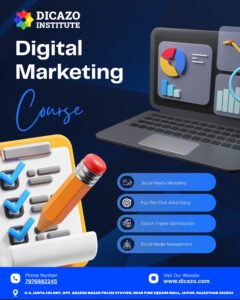By Dicazo Institute – Your Pathway to Becoming a Complete Developer
In the fast-growing tech industry, Full Stack Developers are some of the most in-demand professionals. They can work on both the front-end (user interface) and back-end (server-side logic) of an application, making them incredibly versatile and valuable to employers.
At Dicazo Institute, we help aspiring developers build the skills, confidence, and portfolio needed to thrive in this competitive field. This guide will walk you through a step-by-step roadmap to becoming a successful Full Stack Developer in 2025.

1. Understanding What a Full Stack Developer Does
A Full Stack Developer is proficient in:
- Front-End Development – Everything users see and interact with (web pages, buttons, forms, animations).
- Back-End Development – The behind-the-scenes code that powers the application, manages data, and ensures smooth functionality.
- Databases – Storing, retrieving, and managing data efficiently.
They bridge the gap between design and functionality, ensuring seamless user experiences.
2. Step-by-Step Skills Roadmap
Step 1: Learn the Basics of Web Development
- HTML – Structure of the web page.
- CSS – Styling and layout.
- JavaScript – Interactivity and dynamic features.
Tools: VS Code, Chrome DevTools, Git.
Step 2: Master Front-End Frameworks
- React.js – Most popular front-end library.
- Bootstrap / Tailwind CSS – For fast, responsive design.
- Best Practices: Write clean, reusable components, ensure mobile-friendly layouts.
Step 3: Learn Back-End Development
- Node.js – JavaScript runtime for server-side development.
- Express.js – Framework for building APIs.
- Best Practices: Use RESTful API principles, handle errors gracefully.
Step 4: Understand Databases
- SQL Databases – MySQL, PostgreSQL.
- NoSQL Databases – MongoDB.
- Best Practices: Normalize data, ensure security with proper authentication.
Step 5: Version Control & Collaboration
- Git & GitHub – For managing and sharing code.
- Best Practices: Use meaningful commit messages, work in branches.
Step 6: Learn Deployment & DevOps Basics
- Platforms: Netlify, Vercel, Heroku, AWS.
- Best Practices: Automate deployments, monitor performance, use environment variables for security.
Step 7: Build Real-World Projects
- Portfolio Website
- E-commerce Store
- Blog Platform with Authentication
- Chat Application
3. Essential Tools for Full Stack Developers
| Category | Popular Tools |
|---|---|
| Code Editor | VS Code, Sublime Text |
| Version Control | Git, GitHub, GitLab |
| Front-End | React, Vue, Angular |
| Back-End | Node.js, Express, Django |
| Database | MySQL, MongoDB, Firebase |
| Deployment | Netlify, Heroku, AWS |
4. Best Practices to Follow
- Write clean, modular code.
- Use responsive and accessible design principles.
- Keep security in mind (avoid SQL injection, encrypt sensitive data).
- Test applications thoroughly before deployment.
- Keep learning and adapting to new tools and trends.
5. How Dicazo Institute Can Help You
At Dicazo Institute, we don’t just teach theory — we focus on:
- Practical Projects: Build real-world applications from day one.
- Latest Tools: Learn with the same tools top companies use.
- Industry Mentors: Get guidance from experienced developers.
- Placement Assistance: Prepare for interviews and land your dream job.
Whether you’re a beginner or looking to upgrade your skills, our Full Stack Development Course in Jaipur will give you the skills and confidence to succeed.
Final Thought:
The journey to becoming a Full Stack Developer is challenging but rewarding. With the right skills, tools, and best practices, you can create powerful, scalable, and user-friendly applications. Start your journey with Dicazo Institute today and step into the future of web development.
Ready to become a Full Stack Developer? Join Dicazo Institute’s hands-on training program in Jaipur. Contact us today!
More Courses




